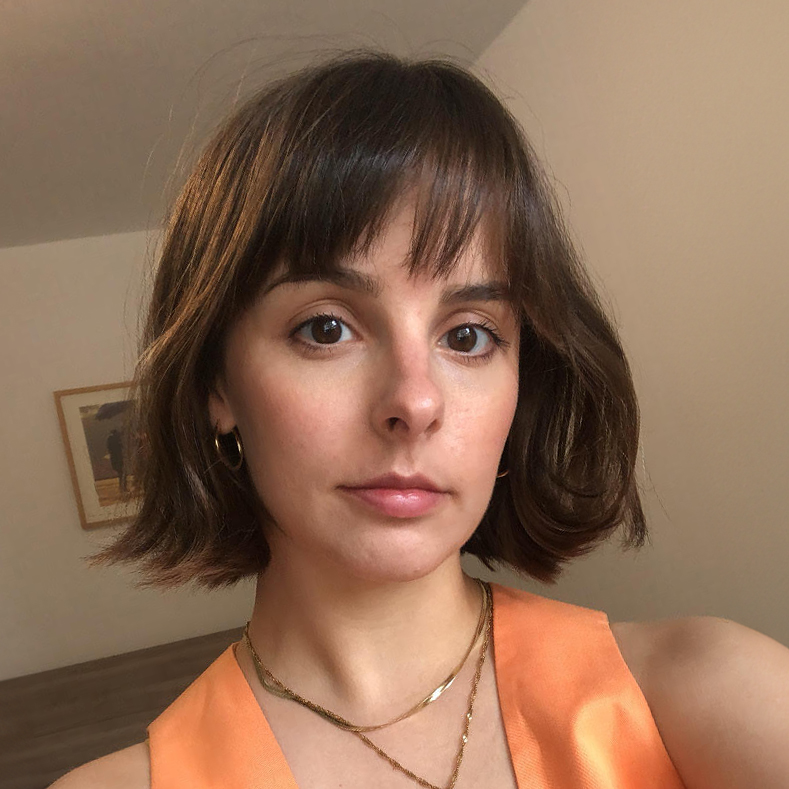‘We couldn’t go around digging holes in existing graveyards for fear of exhuming a real body’: The man who brought The Thursday Murder Club to the big screen
Lotte Brundle caught up with James Merifield, the production designer behind the new Netflix film adaptation of the Richard Osman novel, to chat about the murder mystery.
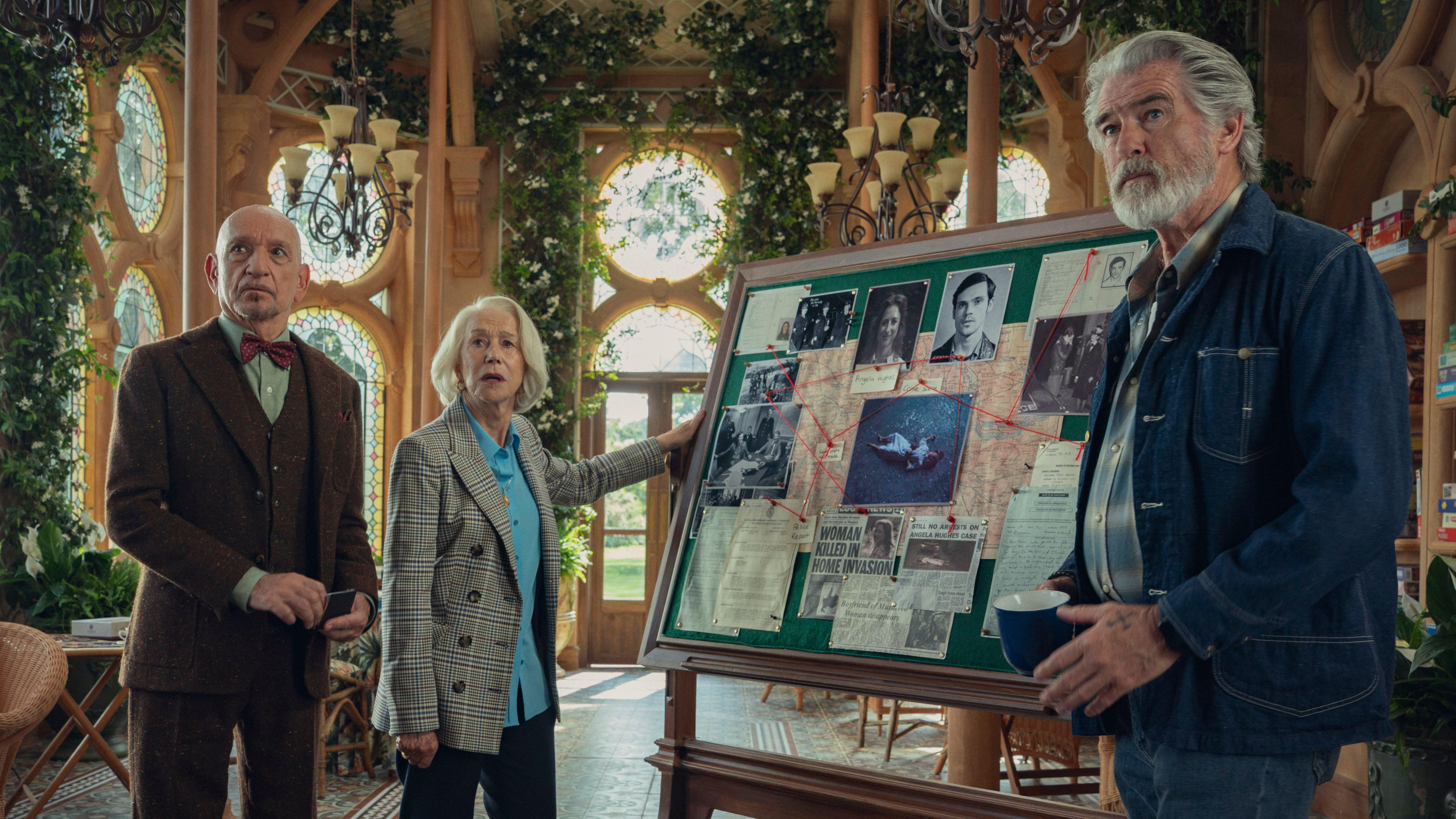
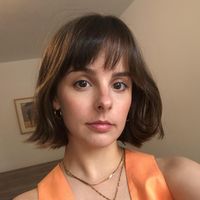
If you haven’t read The Thursday Murder Club, Richard Osman’s debut Sunday Times bestseller, then you are in the minority. The crime novel sold 45,000 copies in its first three days and has been a hit, spawning a whole book series — so it was no surprise when a film adaptation followed.
Chris Columbus, the American director behind Mrs. Doubtfire and Home Alone, has brought his keen eye to The Thursday Murder Club, streaming now on Netflix. The film follows four retirees, Elizabeth (Helen Mirren), Joyce (Celia Imrie), Ibrahim (Ben Kingsley) and Ron (Pierce Brosnan), as they attempt to solve a murder from the comfort of Coopers Chase, their luxury retirement home in Kent.
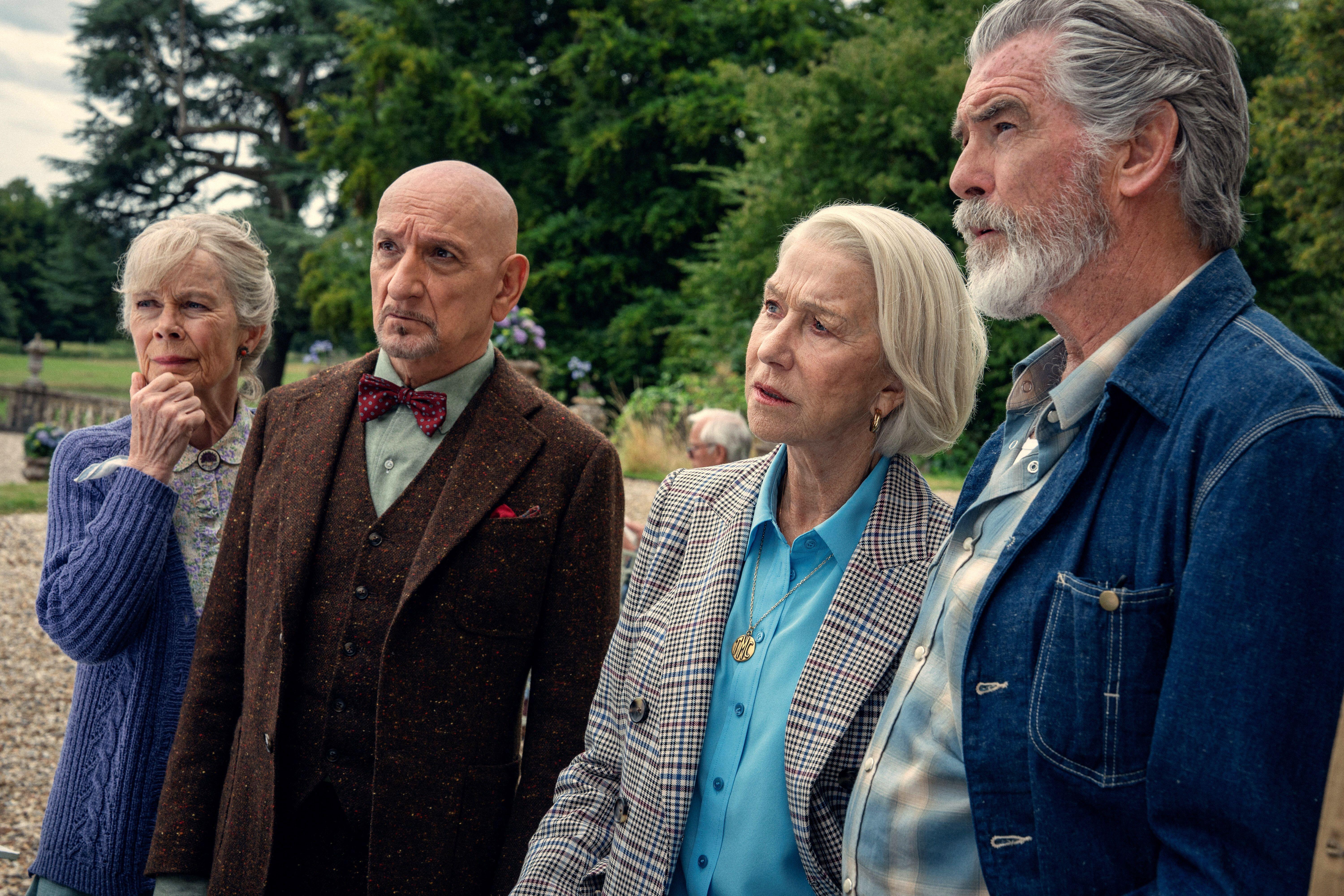
‘Donna is not the first visitor to Coopers Chase to think this wouldn’t be the worst place to live,’ we’re told in the book when a local police officer pays a visit. This aside, the novel's locations are rarely described, giving the film adaptation free range when it came to manifesting The Thursday Murder Club’s world. This was a dream for the production designer James Merifield, who has previously worked on Mary Queen of Scots, Mortdecai and, the quirkily named, The Guernsey Literary and Potato Peel Pie Society.
Filmed, for the most part, in the rolling grounds of Englefield Estate in Berkshire, The Thursday Murder Club brings the extravagant characters of Osman’s book, and their beloved surroundings, to life with relish. James spoke to Country Life about the process and how he designed a luxury home that we’d all die to retire in.
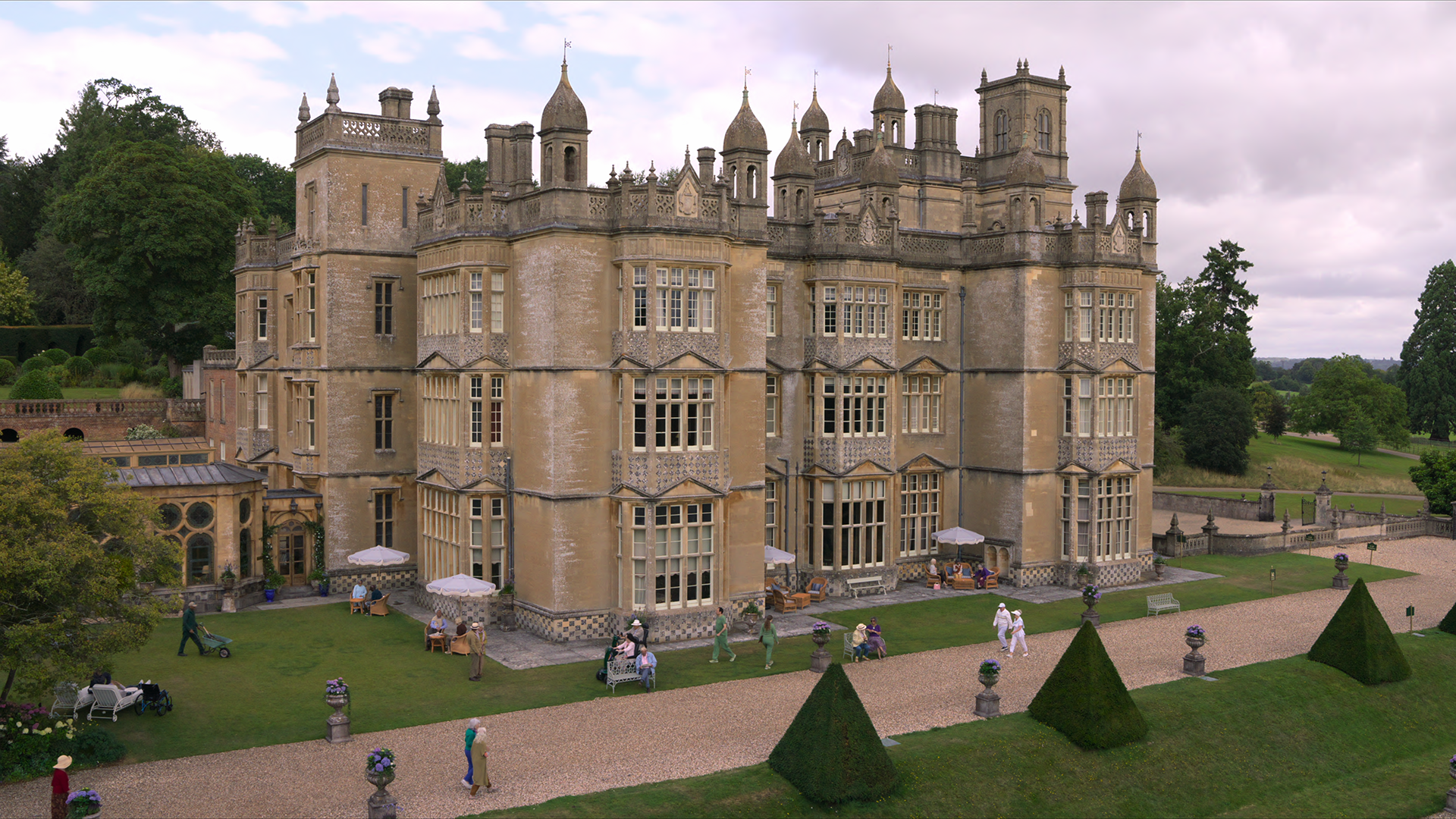
Englefield was transformed into Coopers Chase for the film.
Country Life (CL): How did your involvement with the film come about?
James Merifield (JM): The script came about via the producer, Jennifer Todd. I had worked on a series called We Are the Lucky Ones, which was completely contrasting with this (it was set in the time of the Holocaust), but Chris Columbus had seen it and then, very kindly, wanted to meet with me to talk about working on The Thursday Murder Club.
CL: Were you a fan of the novel before you started working on The Thursday Murder Club?
Exquisite houses, the beauty of Nature, and how to get the most from your life, straight to your inbox.
JM: No, I hadn’t read the books before. I read the first [in Osman’s series] after reading the script, and I’ve since read the second as I was keen to know what happens next!
CL: Was this your first time working with Chris?
JM: My very first, and it was an absolute joy. I felt we really connected well and also that our US/UK creative sensibilities conjoining was interesting. Obviously I'm from England and have experience of the landscape [where the book is set] hence the location we found for Coopers Chase, Englefield House. I had filmed there once before on Breathe, directed by Andy Serkis, and when I read the script it immediately sprang to mind.
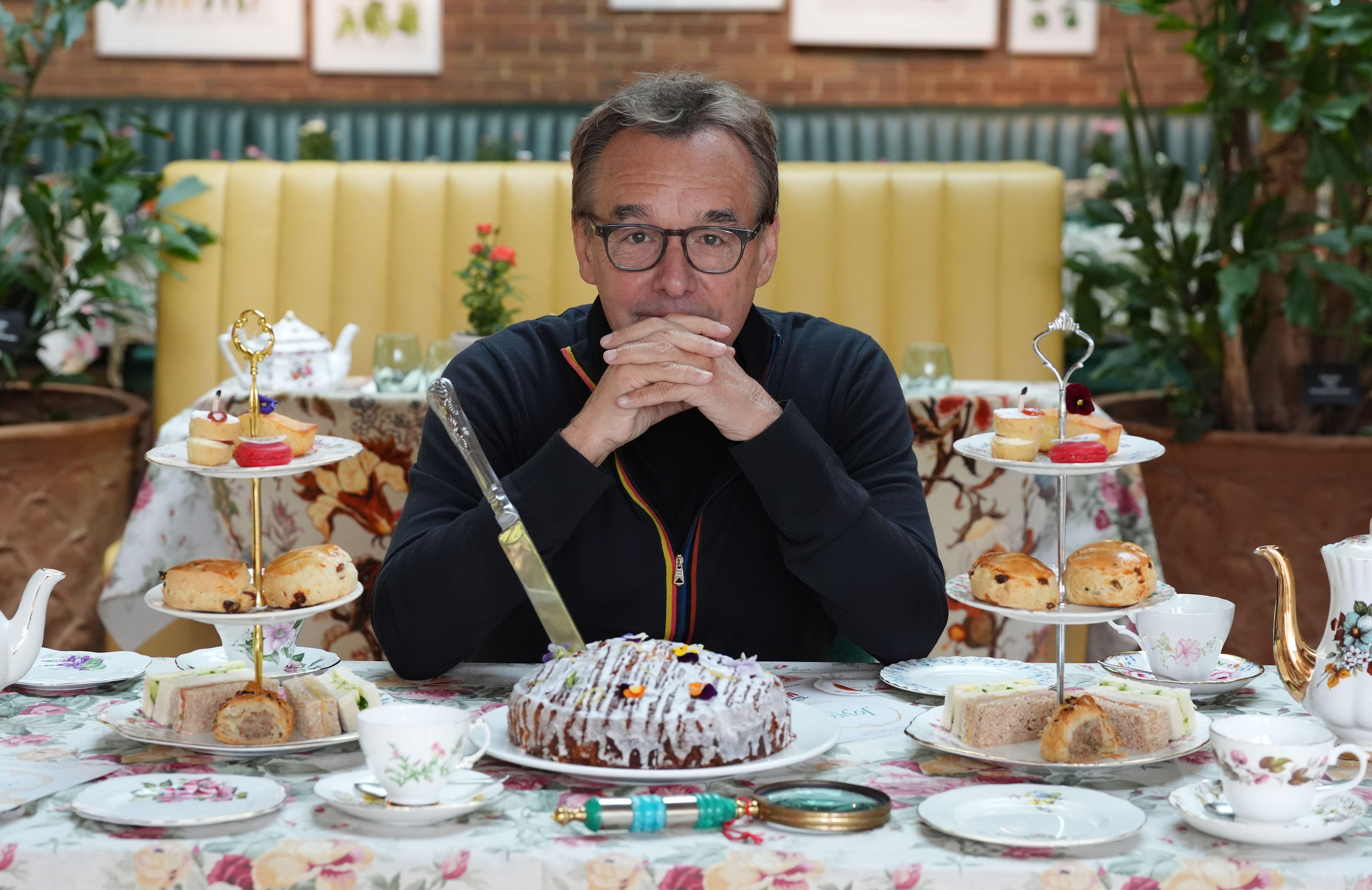
Chris Columbus directed the first two Harry Potter films and Mrs. Doubtfire.
CL: What was it about Englefield that made it the perfect choice for Coopers Chase?
JM: A few things. Obviously, the geography of the house — the fact that it is within its own grounds, which lent itself to this idea that this is an old stately home that's been converted into a luxury retirement complex, but, there's also a church there, and its relationship to the church features heavily in our story, especially the part with the graveyard, which we had to build. For obvious reasons, we couldn’t go around digging holes in existing graveyards for fear of exhuming a real body. That building, the architecture, also lent itself [to Coopers Chase]. It has an Elizabethan wing, it has a Georgian wing, a Victorian wing, even a very modern wing, that we don't show in our story. So it lent itself very well to feeling like there were generations of people that had lived there before, and now a whole new generation of retirees.
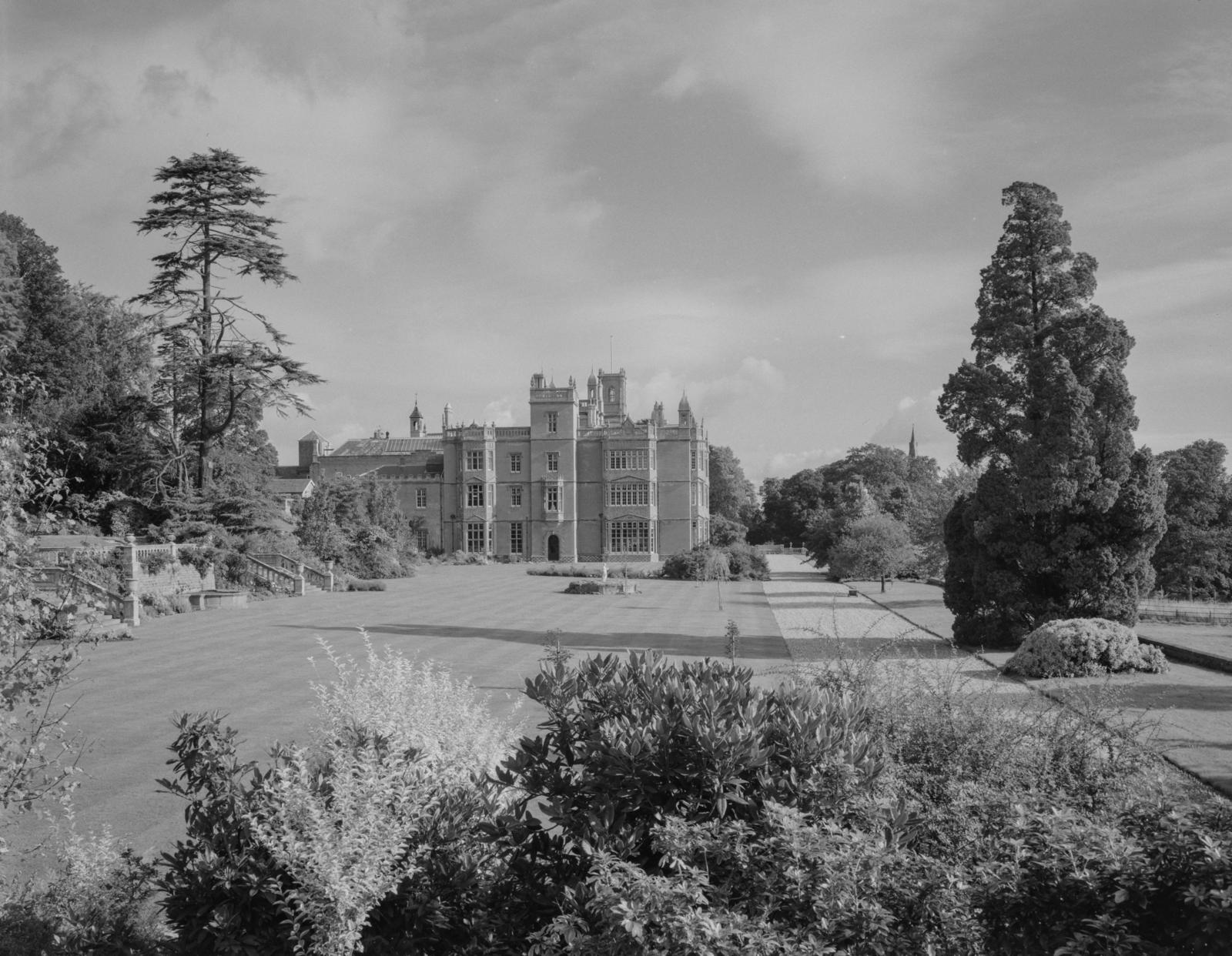
The west front and terraces of Englefield House, photographed by Country Life in 1981.
CL: How much did you deviate from the novel when designing the locations?
JM: Obviously, if you’ve read the book, you probably thought: ‘That's not what I was expecting’. It's far grander, far more exotic than the book perhaps describes, but, you know, this is a film. We needed to make something so that these wonderful characters had a home from which they could get deep and dirty into the solving of these crime cases. But, the book talks about having llamas — I mean, come on. Anywhere with llamas was going to be quite an eccentric place.
CL: What was the most important set to get right?
JM: The Jigsaw Room. In the novel, it's described as a four-walled room somewhere buried within the bowels of the building — it doesn't really say very much about its style or architecture. But we thought, why don't we put it in an orangery? So what you see in the film we built onto the side of Englefield.
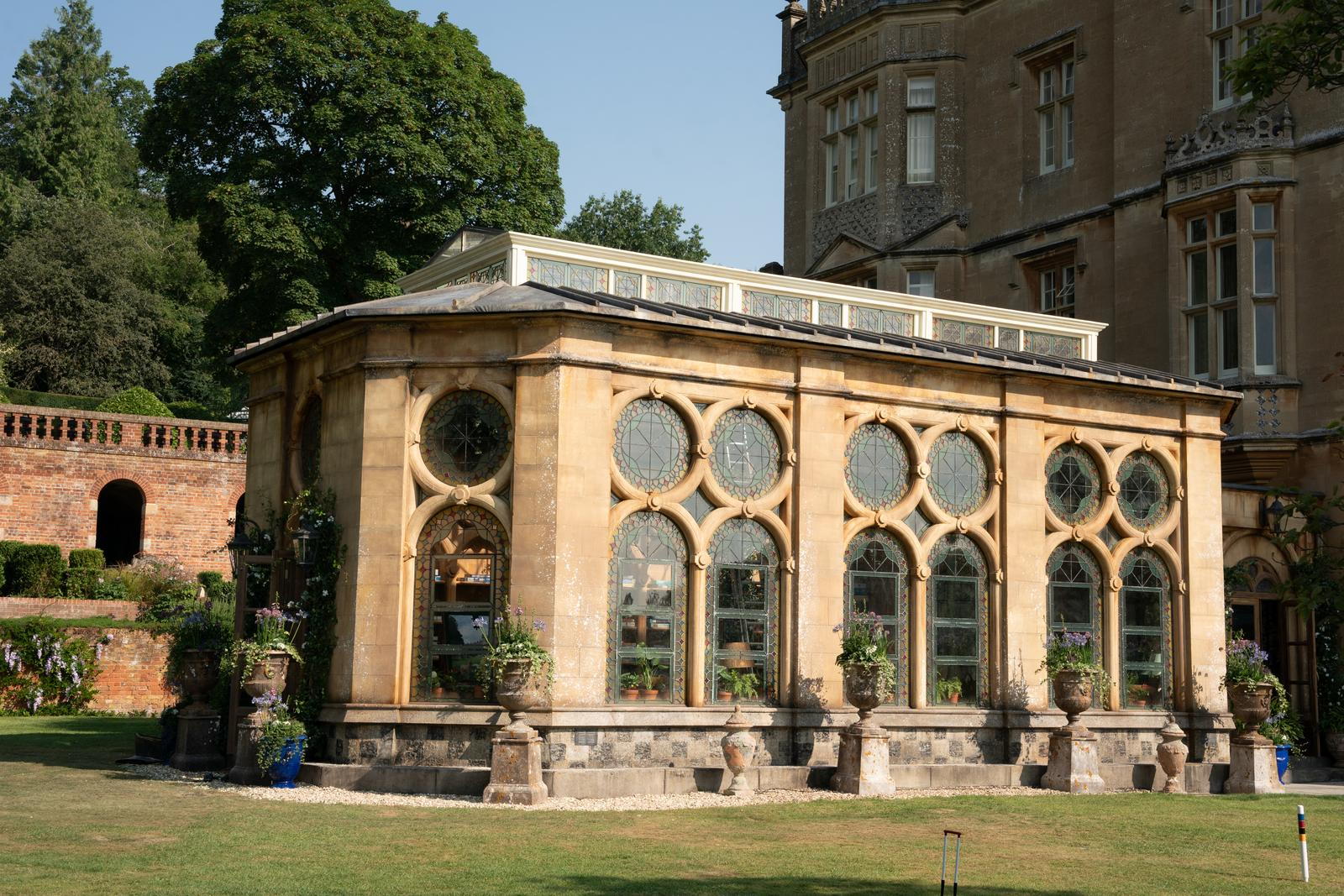
The orangery, or Jigsaw Room, built onto the side of Englefield.
CL: Much of the film is set outdoors, how much of the filming was weather dependent?
JM: We were very blessed with the weather. Overall it was, as you can see in the film, very sunny and beautiful. There were, of course, days when it was windy or rainy. I mean, for instance, we had just finished building the orangery and the heavens opened. The set flooded, fortunately not on a day they were going to be filming in it. It was the night before, so suddenly my team were down at B&Q buying those Aquavacs, and we were all there with mops and rags and towels. But on camera it looks as though the sun was always shining.
CL: This is an story from an English author, set in England, but directed by an American. How important was it to you that the English countryside was showcased in the film?
JM: Obviously, Chris had worked here before. He did [Harry] Potter and lived here for two or three years, so he's sort of an anglophile anyway, but a good example was finding the location for the police station. We set it in a little village called Albury in Hertfordshire, with the perfect, idyllic duck pond, the thatched cottages, the picket fences and the little corner shop, and what it had there was this village hall. I thought straight away that it was perfect — because I remembered my childhood, in a little village in Derbyshire, where the police station was like a house, set within the village. Chris was like: ‘Are you sure, James. Is this really the case?’ So, of course, I found reference pictures for Chris of police stations in the past to show him.
'Richard doesn't really write descriptions of the rooms in the book, it's very much left to the audience to imagine. So in my case, as a production designer, it was great because I was able to interpret how I felt the characters would reside'
CL: I’m curious about each character’s apartment. How much of that was based on the script and how much was influenced by the actors?
JM: The ideas, in terms of decor, very much came from the characters. Richard doesn't really write descriptions of the rooms in the book, it's very much left to the audience to imagine. So in my case, as a production designer, it was great because I was able to interpret how I felt the characters would reside.
Elizabeth is the traveler, she's international, she’s ex-MI6, she's seen the world, so her room is filled with antique decor, artifacts from her travels. Also, she dresses as the Queen at one point in disguise, so her space has a regality to it. It should be elegant and feel like we'd all like to live in it, whether we're 40 or 80.
With Joyce, as we know, she bakes a lot — hence, Mary Berry came to life. We referred to her apartment as the lemon drizzle cake, because it is every single mix-matched pattern of flour and icing sugar. It's very yellow and pink, and very much in line with the cakes that she's making.
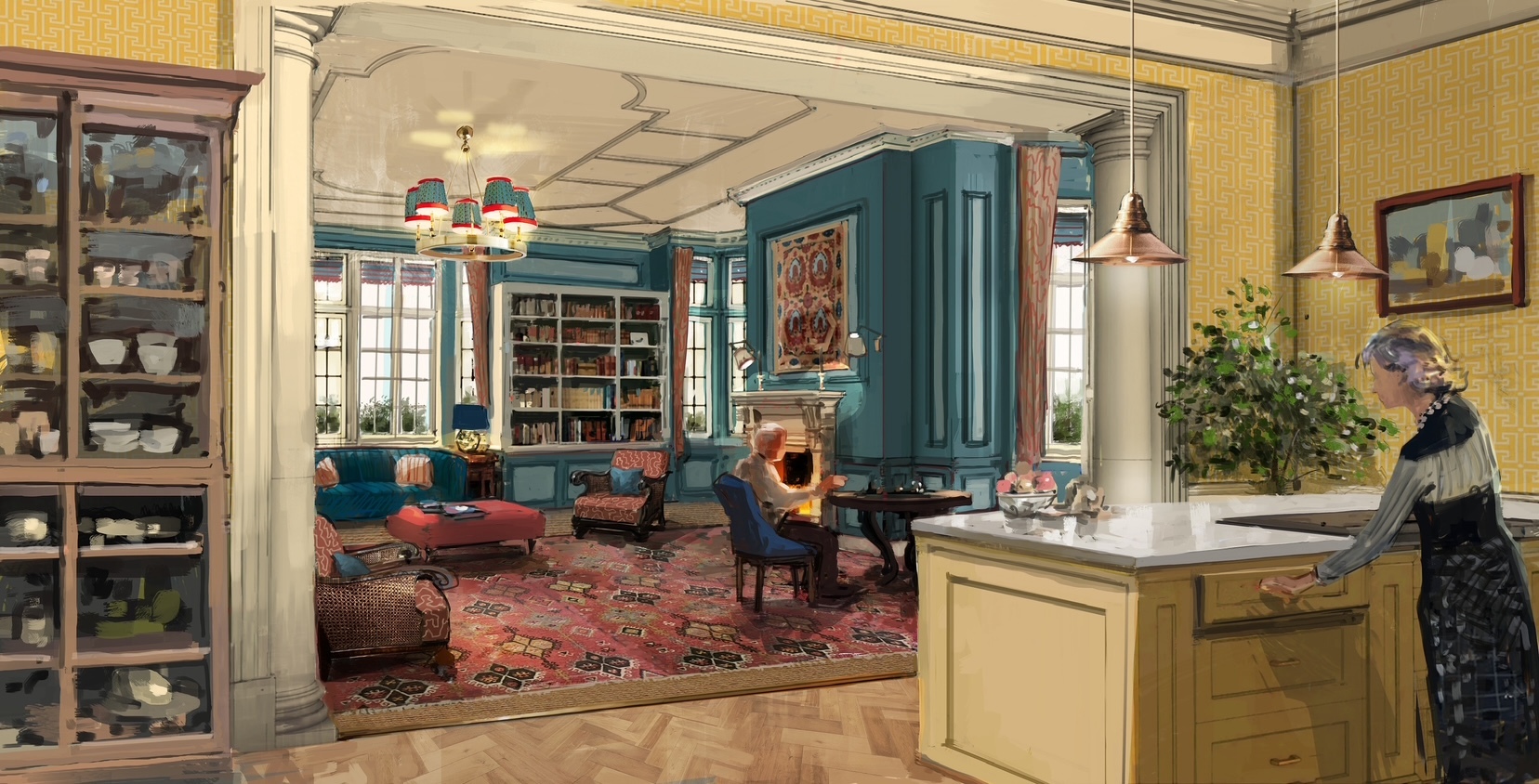
Concept art of Elizabeth's apartment.
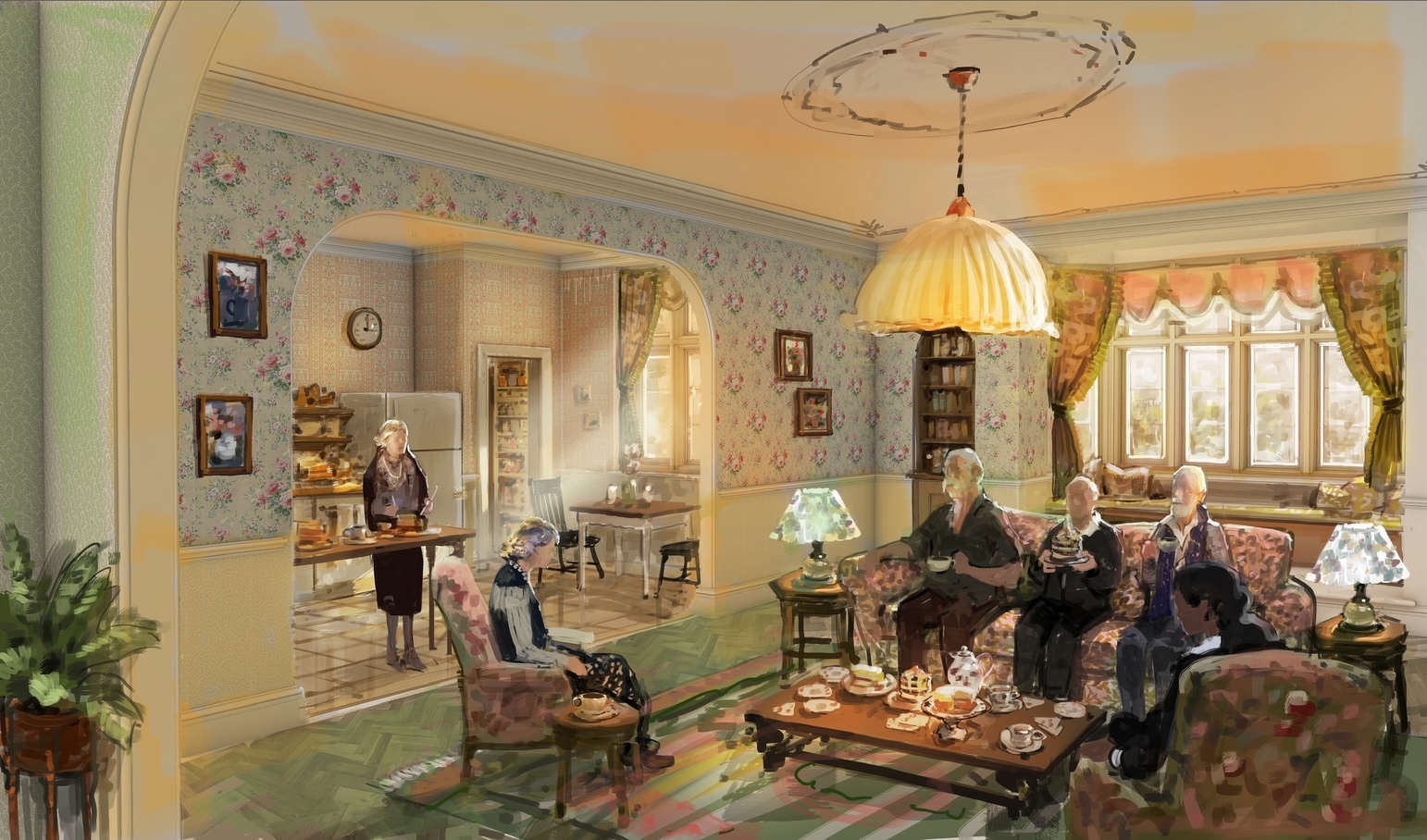
Concept art of Joyce's apartment.
And then you have Ibrahim, who we felt was the serious one. He's the ex-psychiatrist, so we built a psychiatrist’s room, really, with a psychiatrist’s sofa and dark-crimson paneled wallpaper.
And then you've got Ron, who is this eccentric rebel who we put in the attic. He's got the beer pump in the kitchen [Chris's idea], the big flat screen TV and the punch bag. He's still living his youth.
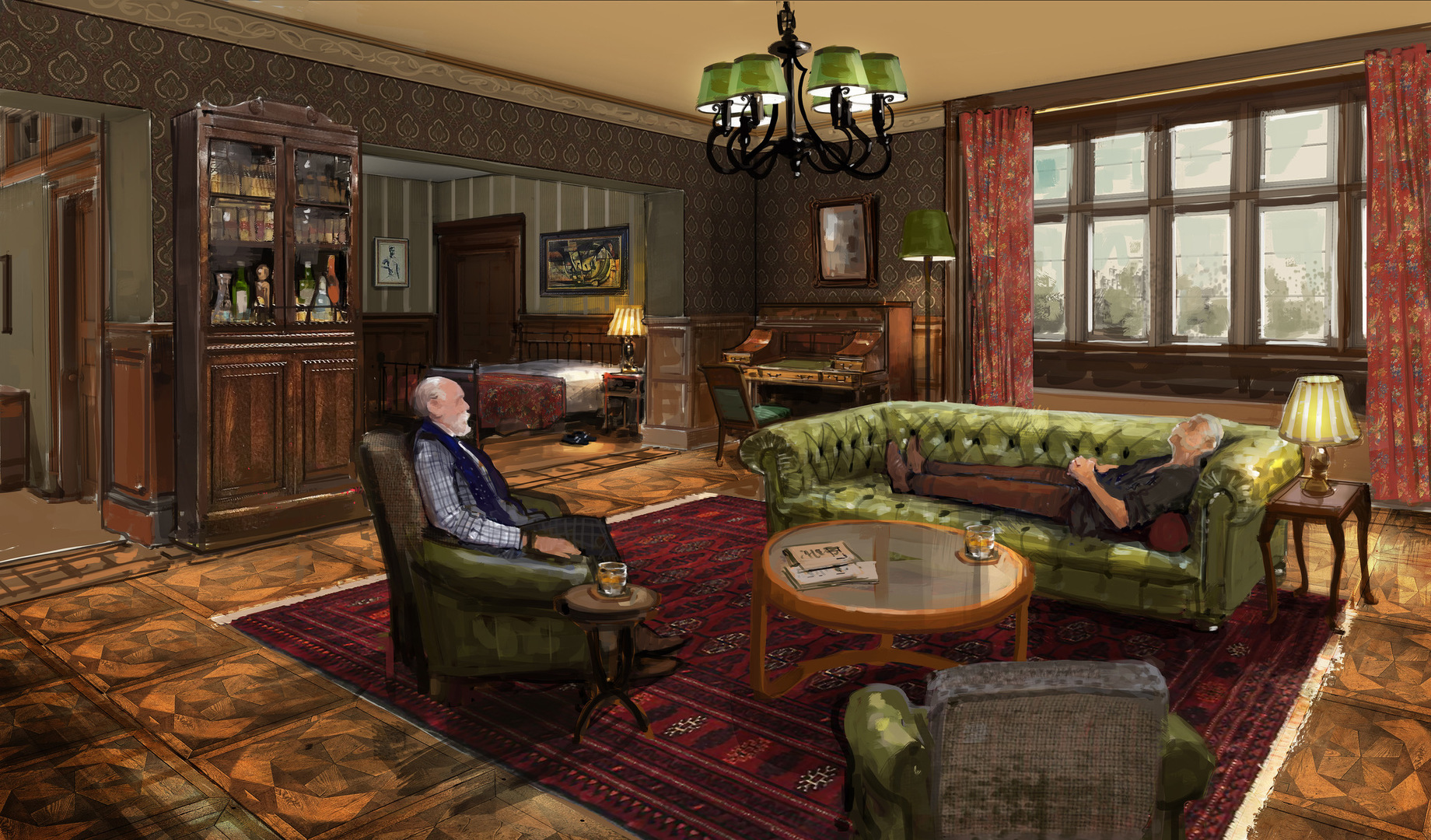
Concept art of Ibrahim's apartment.
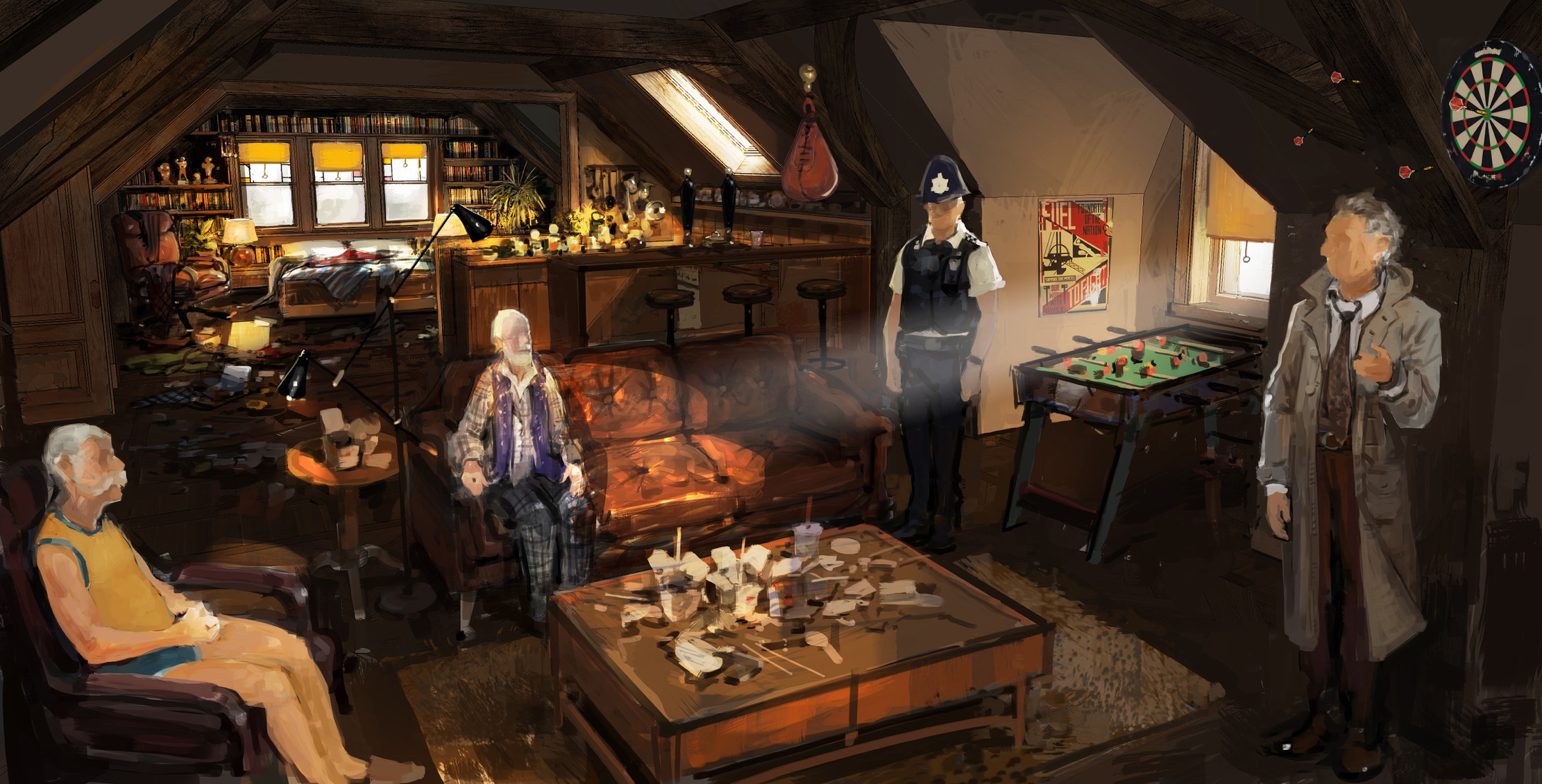
Concept art of Ron's attic room.
CL: I’m keen to know about the pub, how did you go about choosing it?
JM: That was actually the hardest location to find. You’d think it would be easy, but we wanted something quintessentially English and cottagey — the problem with that is that they all have very low ceilings, and for shooting purposes it makes it impossible. So, funnily enough, it was my local pub.
CL: What was the biggest challenge of putting the novel onto the screen?
JM: I think the challenge is feeling that you've honoured the book and honoured all of those die-hard fans. We wanted to create something, hopefully, that's honest and truthful to the story and to the book, and ultimately is character-led, so all four of our leads were shown mood boards for their set concepts, so the actors were involved from the very day they started.
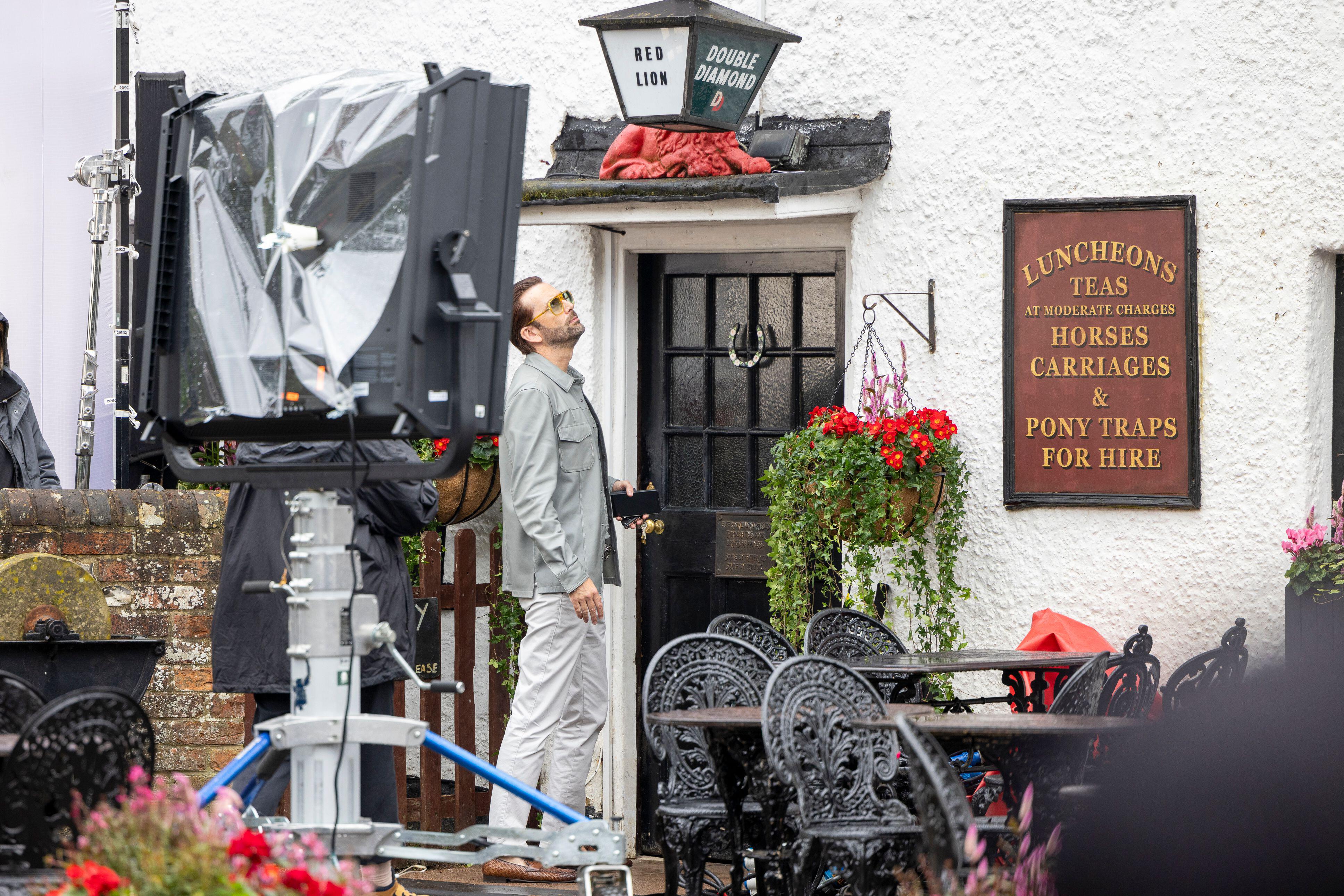
David Tennant on set at James's local.
CL: Do you have a favourite set?
JM: Joyce’s apartment made me smile the most, but probably the Jigsaw Room, because it was quite a challenge as a design piece, to design something architecturally that is seamless to the real architecture of the building. And, funnily enough, after I had designed the orangery I went to the house and saw a black and white photograph of an orangery from the 19th century, in the very same spot that we built ours. So obviously it was meant to be.
CL: And finally, many years from now, when you retire, if you were in Coopers Chase where would you like to live?
JM: I’d have to stay in Elizabeth’s apartment. You see, I’m 6ft 2in tall, so I need the higher ceilings. I love panelling, I love the colour that we chose. At those big windows she has, I could set my drawing board up and design the sets of the next Thursday Murder Club instalment.
Lotte is Country Life's digital writer. Before joining in 2025, she was checking commas and writing news headlines for The Times and The Sunday Times as a sub-editor. She has written for The Times, New Statesman, The Fence and Spectator World. She pens Country Life Online's arts and culture interview series, Consuming Passions.
-
 What on earth is the person who comes up with Annabel's otherworldly facade displays on? London's most magical Christmas shop displays
What on earth is the person who comes up with Annabel's otherworldly facade displays on? London's most magical Christmas shop displaysPhotographs by Greg Funnell.
-
 What trees taught me about perfect planting — Alan Titchmarsh
What trees taught me about perfect planting — Alan TitchmarshSense and patience is key to growing healthy trees, as a certain Mr Mackenzie showed a young Alan Titchmarsh
-
 What on earth is the person who comes up with Annabel's otherworldly facade displays on? London's most magical Christmas shop displays
What on earth is the person who comes up with Annabel's otherworldly facade displays on? London's most magical Christmas shop displaysPhotographs by Greg Funnell.
-
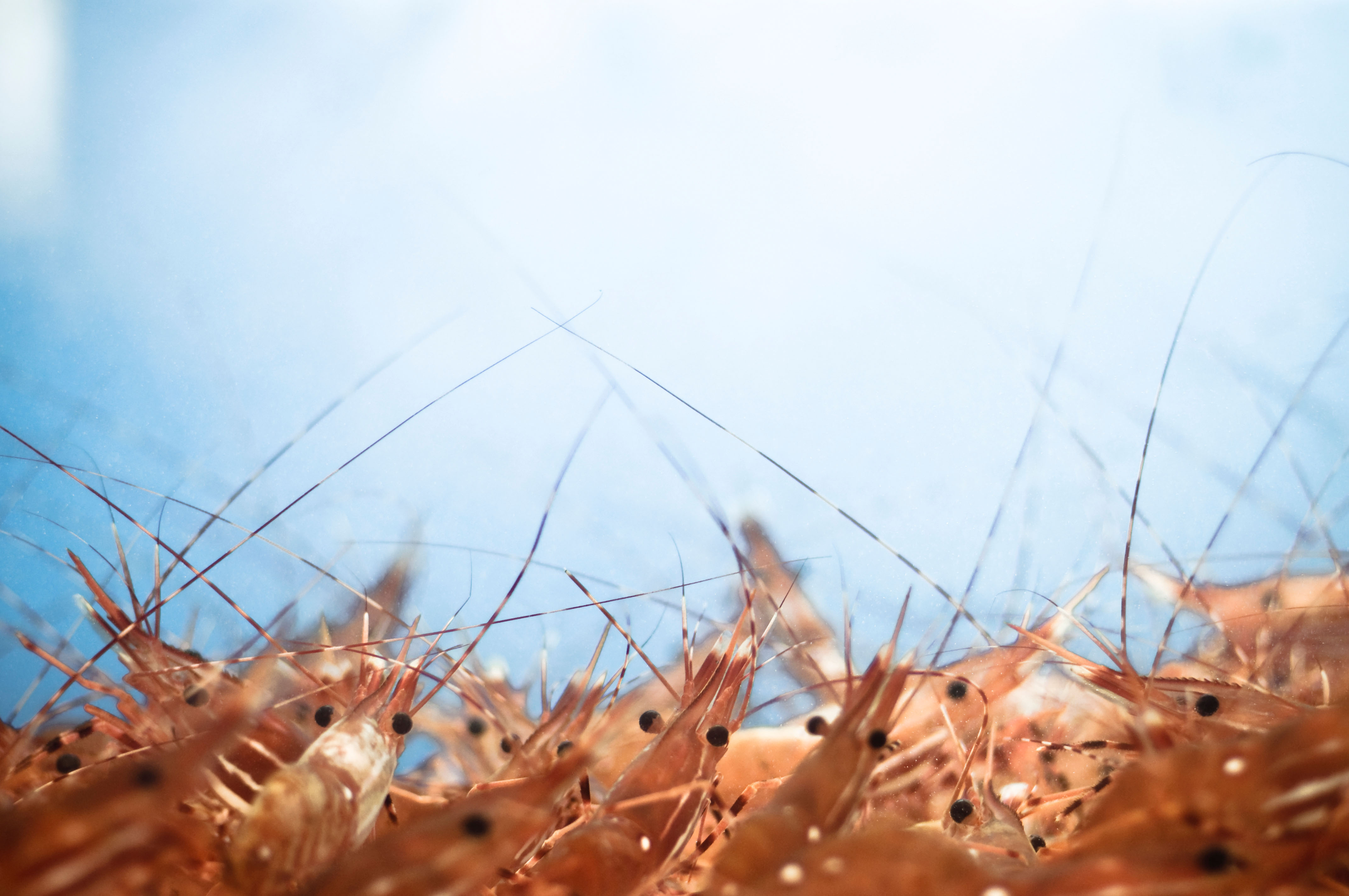 Farmers of Britain, go forth and grow prawns
Farmers of Britain, go forth and grow prawnsA new study has proposed that farmers could start growing king prawns to diversify income streams.
-
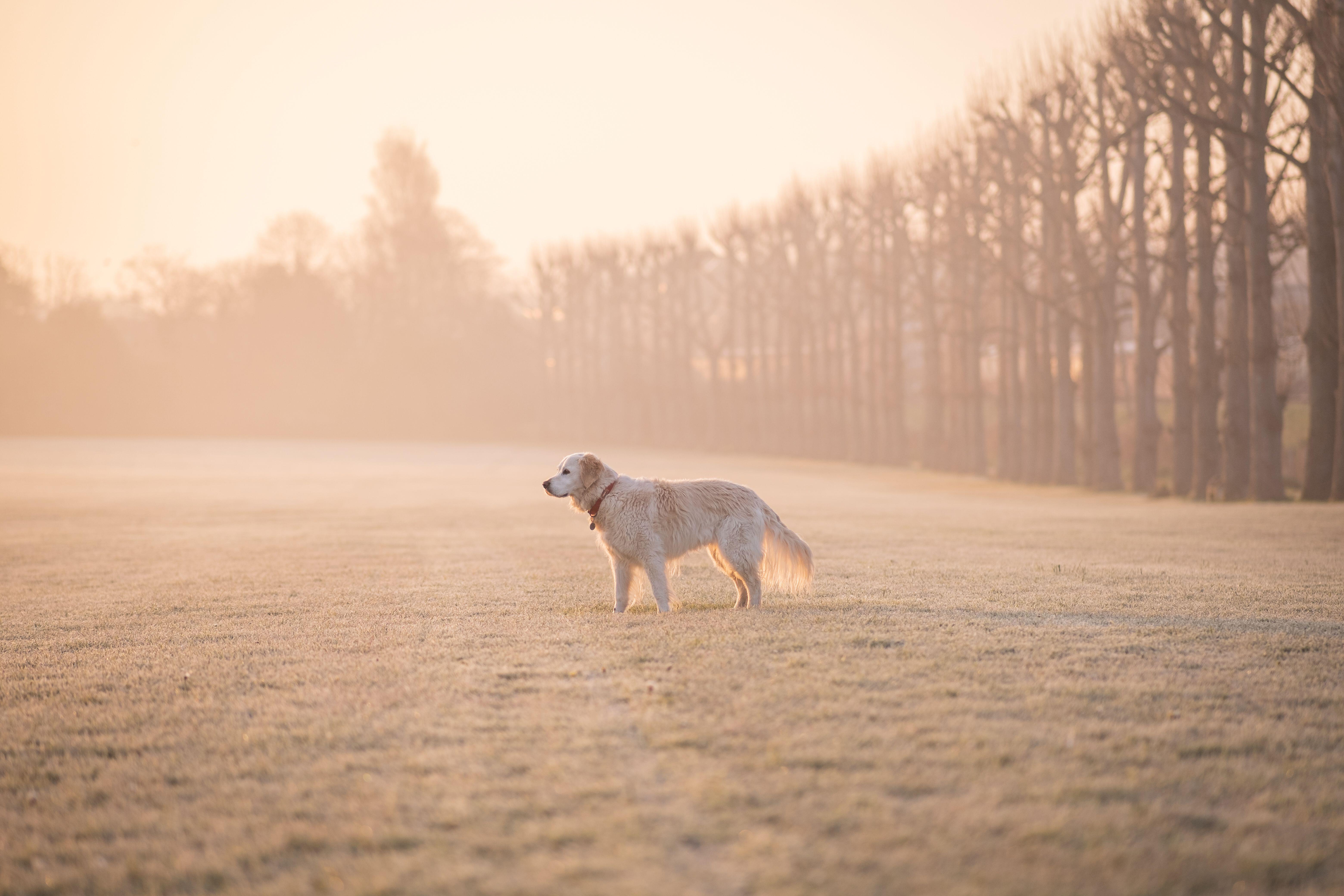 The golden retriever: The world’s most likeable dog almost didn’t exist at all
The golden retriever: The world’s most likeable dog almost didn’t exist at allThey’ve been popping up everywhere this week — on the Tube, at Christmas parties and in the news — so it feels like the perfect moment to talk about the dog breed we’re lucky to have.
-
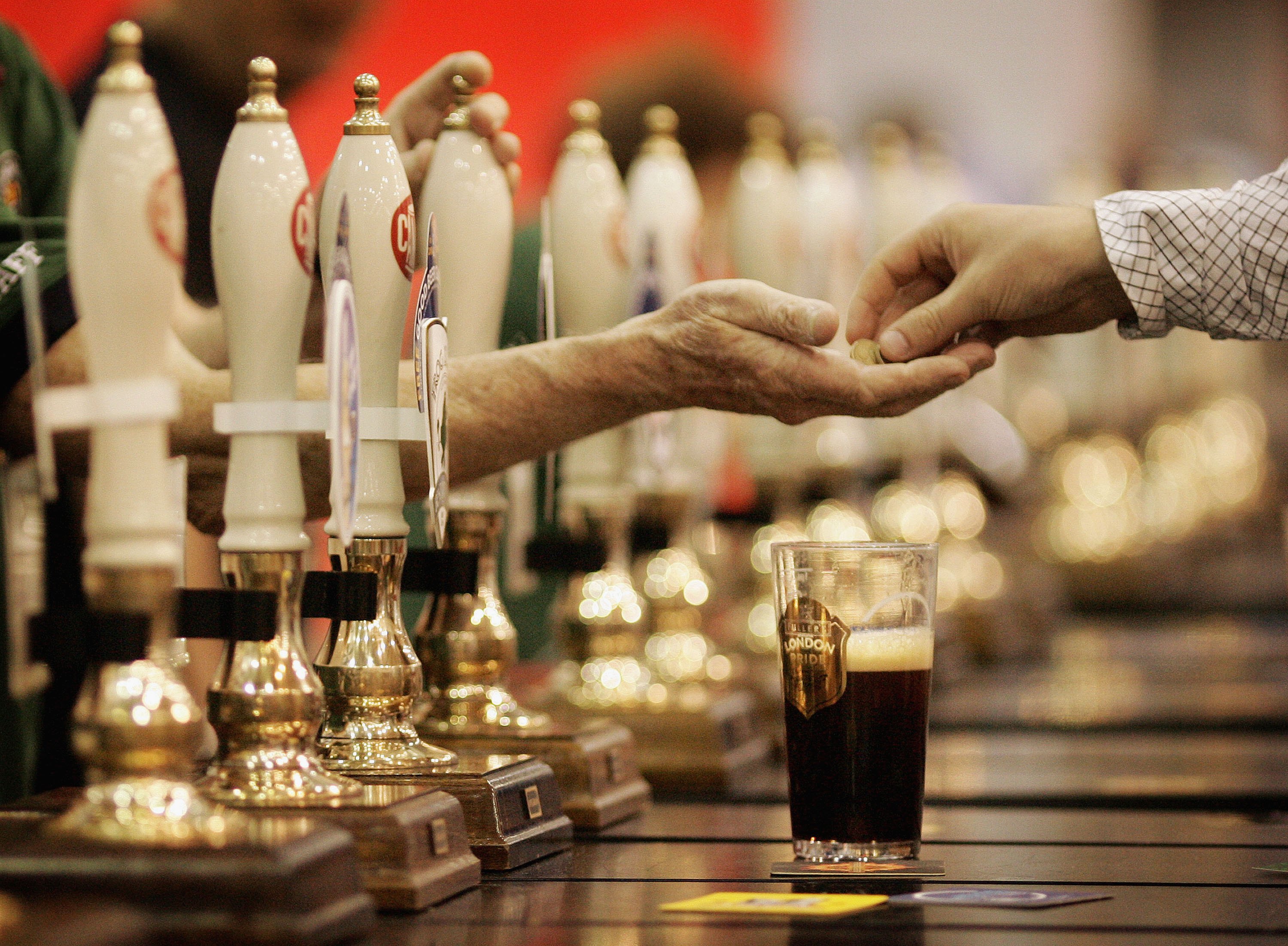 In search of London’s earliest pint
In search of London’s earliest pintEarly houses — pubs open in the early hours to feed and water the market trade — have been a cornerstone of London for centuries. Yet, as Will Hosie finds, they aren’t stuck in the past.
-
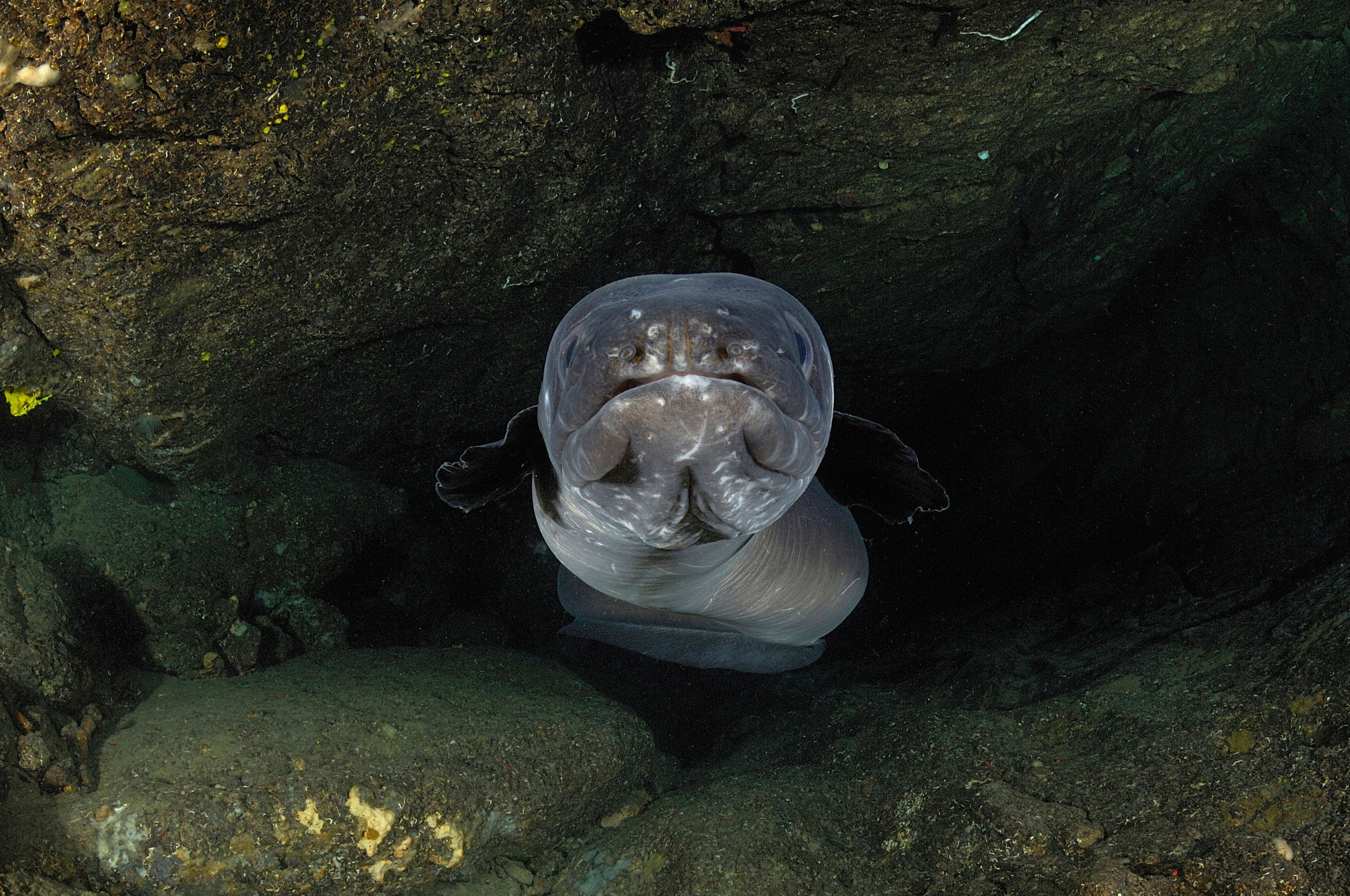 Aristotle believed they emerged spontaneously from mud, Sigmund Freud dissected thousands of them and they can dive lower than a nuclear submarine — but what is the truth about the eel?
Aristotle believed they emerged spontaneously from mud, Sigmund Freud dissected thousands of them and they can dive lower than a nuclear submarine — but what is the truth about the eel?It would seem the European eel has a long way to go to win hearts, Laura Parker says of the slippery animal with an unfortunate image problem.
-
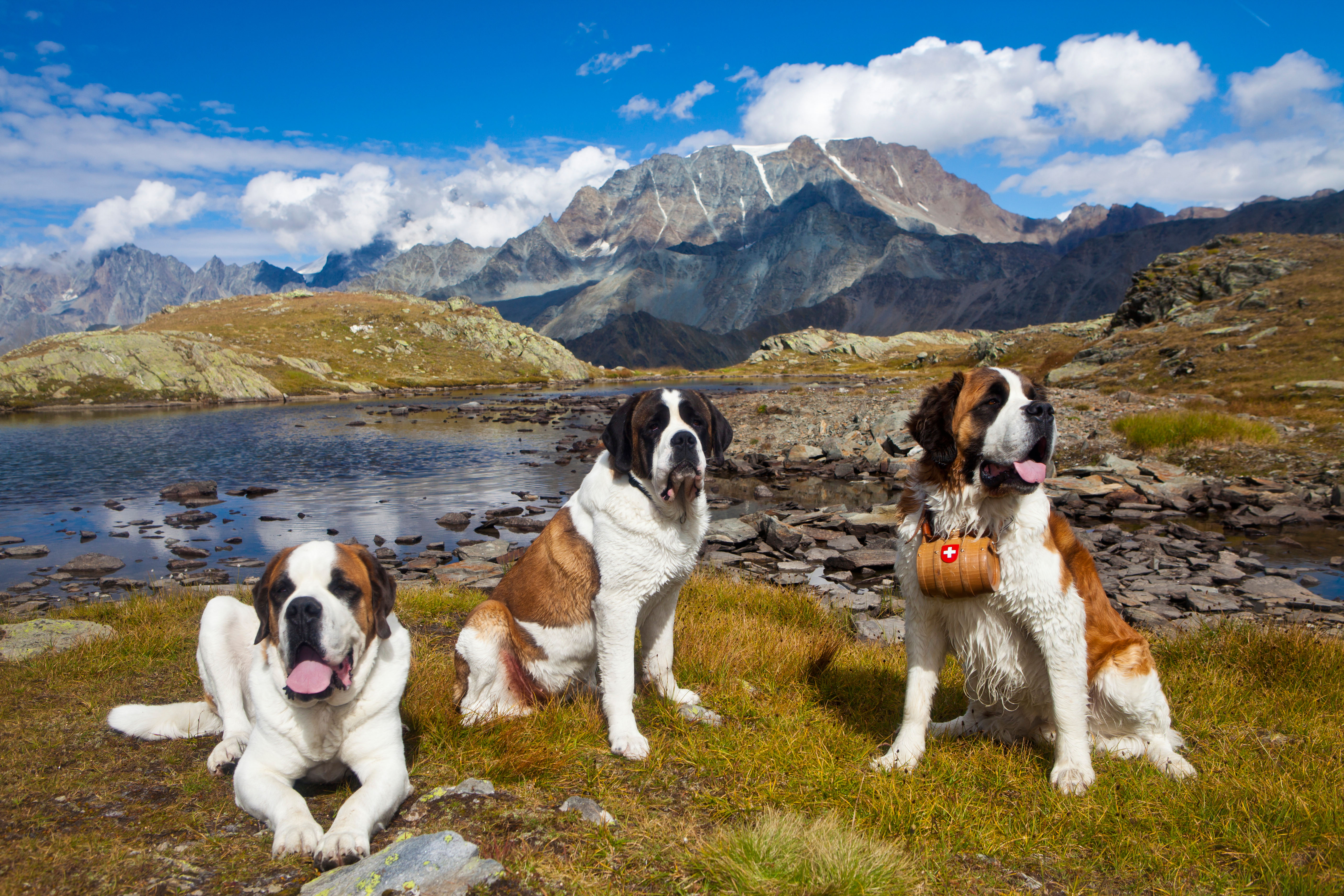 The Alpine rescue dog built for blizzards, bred by monks
The Alpine rescue dog built for blizzards, bred by monksAs snow fell across the UK this week, I found myself day-dreaming of St Bernards striding through the Alps — a snow-day dog worth celebrating.
-
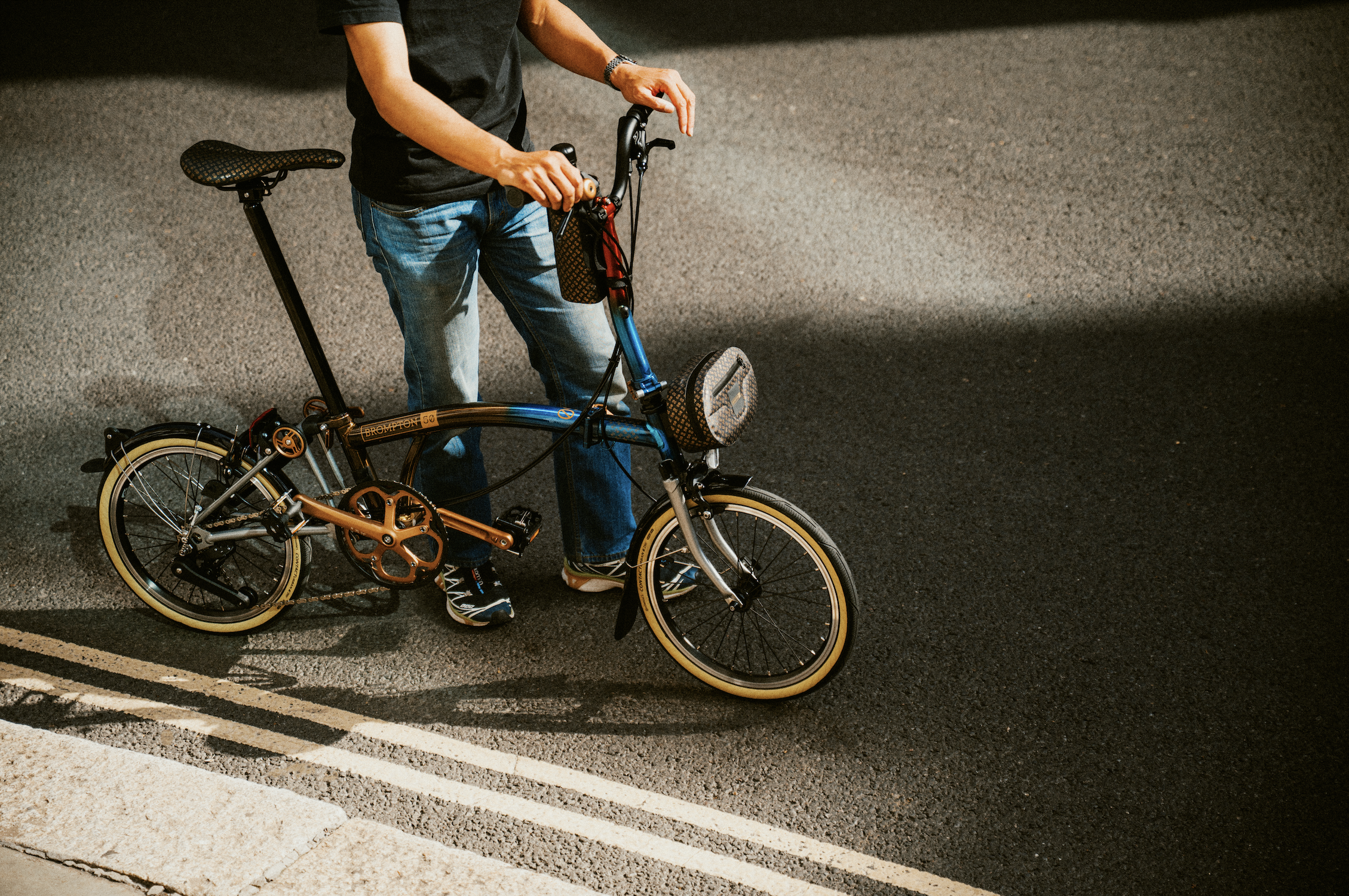 Better than Ozempic? 50 years of the Brompton bicycle
Better than Ozempic? 50 years of the Brompton bicycleOwen Wilson, James May and most of the middle-aged men and condescending hipsters you know love them. As the iconic folding bike turns 50 Lotte Brundle hops on one with the company's CEO.
-
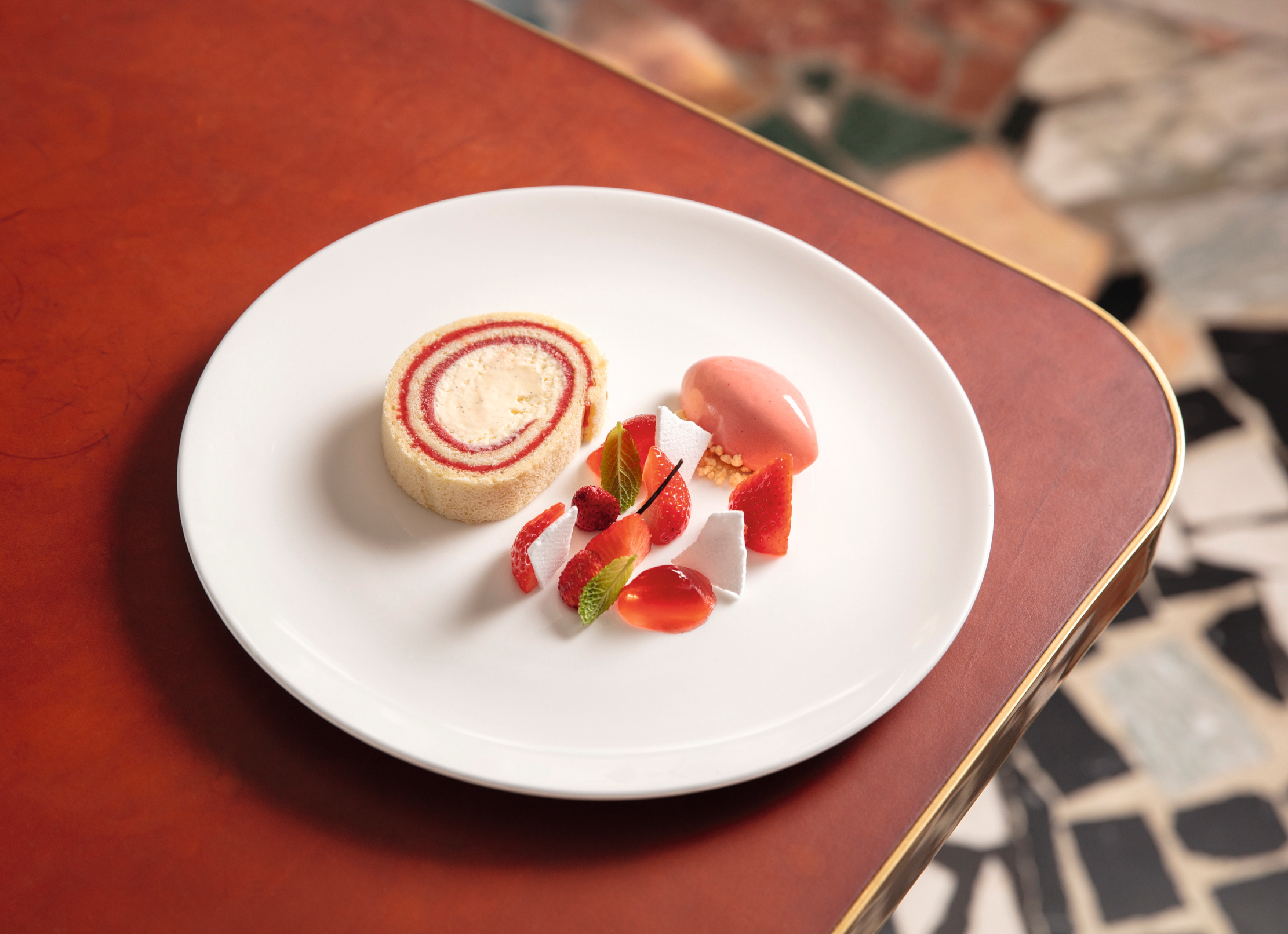 No more froths, no more foams, no more tweezers. Classic dining is making a comeback. Thank god
No more froths, no more foams, no more tweezers. Classic dining is making a comeback. Thank godFrom prawn cocktail and Arctic roll to starched tablecloths and ‘nicotine cream’ on the walls, it’s out with the new and in with the old in the restaurant world

